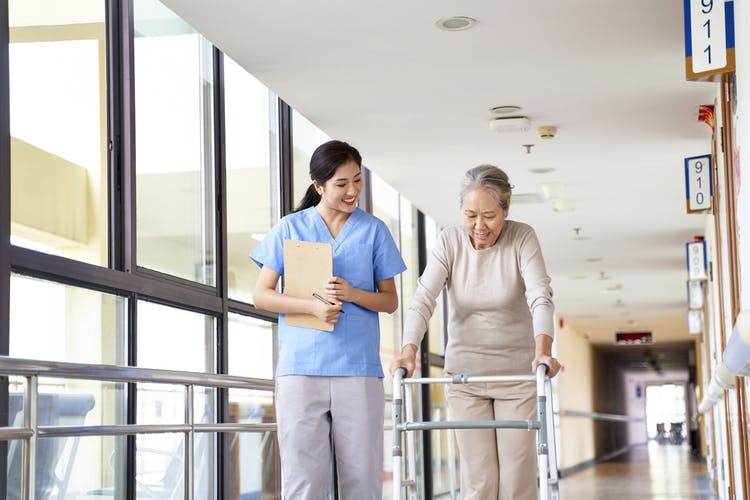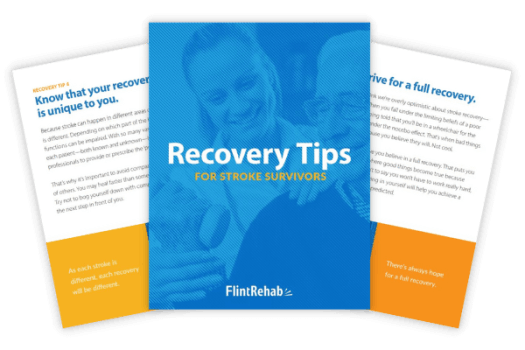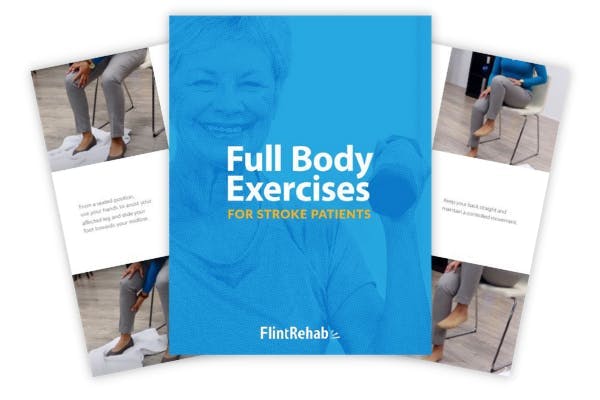No products in the cart.
No products in the cart.
No products in the cart.
No products in the cart.
Home » Neurological Recovery Blog » Stroke » 5 Stroke Paralysis Treatments That Provide Hope for Recovery
Last updated on August 24, 2023

Stroke paralysis treatments can help patients improve their chances of regaining mobility in their affected limbs. Although paralysis impacts many stroke survivors, there are several treatments available to help improve strength and function.
Survivors are encouraged to try different treatment methods because everyone responds differently to specific techniques. After all, every stroke is different, and every recovery journey will be unique.
Before discussing specific treatments, it is important to understand the causes of stroke paralysis. To help you take charge of your recovery, we will review these causes as well as the outlook for rehabilitation. We will also review some of the best treatments for stroke paralysis below. Work together with your therapy team to create a rehabilitation plan that helps you reach your own unique goals.
Stroke paralysis, also known as hemiplegia, usually occurs on the side of the body opposite from the side of the brain affected by stroke. For example, if a stroke occurred in the brain’s left hemisphere, you may experience paralysis on the right side of your body.
This occurs because each half of the brain controls movement on the opposite side of the body. Certain parts of the brain, such as the motor cortex, send a complex array of signals to the muscles in the body. These signals enable you to move your muscles on command.
However, when a severe stroke damages these areas of the brain, those signals become interrupted. As a result, the muscles are not able to respond to the brain’s directions, resulting in paralysis. Keep in mind that the muscles themselves are not damaged. Rather, they are simply not receiving the signals from the brain that tell them to move.
This lack of communication does not only cause paralysis, but can lead to other secondary effects. Some common symptoms that often accompany stroke paralysis include:
Additionally, interrupted signals for movement can sometimes lead to weakness rather than paralysis of the muscles. This is called hemiparesis and, while this can still lead to movement impairment, this is less severe than hemiplegia.
Fortunately, it is possible to treat these symptoms after stroke through a dedicated rehab program. By participating in rehab exercises, many stroke survivors can recover from stroke paralysis and regain mobility on the affected side.
The most effective way to treat stroke paralysis is to activate neuroplasticity. Neuroplasticity refers to the mechanism your brain uses to heal by reorganizing nerve cells and forming new neural pathways.
These new neural pathways then allow healthy, undamaged portions of the brain to take over control from areas that were affected by the stroke. Therefore, by engaging neuroplasticity, you’ll be able to create neural pathways between your brain and muscles to help recover from paralysis.
You can activate neuroplasticity through high repetition or “massed practice” of rehab exercises. The more you practice an activity, the more it reinforces new neural pathways. Subsequently, the more you strengthen those pathways, the stronger and more efficient the connection between your brain and muscles will become.
When a stroke patient is affected by paralysis, they cannot move certain parts of the body on their own in order to exercise them. Fortunately, there are other ways to activate neuroplasticity to compensate for lack of active movement, which we will discuss in the sections below.
Stroke paralysis treatment can take a variety of forms. As we mentioned previously, what works for one person might not work for another. Therefore, it’s important to experiment with different recovery treatments for post-stroke paralysis to find the ones that meet your unique needs.
Survivors generally experience the fastest improvements in function during the first six months of recovery. This is thanks to something called spontaneous recovery, when neuroplasticity is the most active after stroke. However, survivors can continue to make progress for months and even years after stroke.
For this reason, it is important to continue pursuing your goals, no matter what stage of recovery you are in. While survivors often experience a plateau or even a regression, there is always hope for improvement after stroke if you continue moving forward.
The treatments below are not guaranteed to cure post-stroke paralysis, but they can help increase your chances of recovery. Check out our stroke recovery stories for encouraging evidence that these methods can work. To help you get started, here are some of the best stroke paralysis treatments:
Perhaps the most common and effective way to regain mobility after stroke paralysis is to practice passive exercises. During passive exercise, you do not move your muscles on your own. Rather, your affected side is moved on your behalf, either with the help of a therapist or caregiver or by using your non-affected side.
Even though you are not using muscle contraction to perform the movements yourself, passive exercise still helps stimulate the brain and activate neuroplasticity. These exercises may also help minimize spasticity and reduce the chance of developing contractures.
As you move through passive exercises, focus intently on the movement (watch the movement with your eyes and think about the movement in your mind). Eventually, the connection between your brain and muscles can improve, and you might regain some muscle activation and limb movement.
As you move through passive exercises, focus intently on the movement (watch the movement with your eyes and think about the movement in your mind). Eventually, the connection between your brain and muscles will improve, and you might regain a small amount of your movement.
To help you achieve this goal, you can use interactive home therapy devices like FitMi. The FitMi motivates users to accomplish hundreds of repetitions during each exercise session. These exercises can be done passively, too, which has helped many survivors (like Ron’s success story) regain movement after post-stroke paralysis.
Additionally, if you start to notice muscle activation and independent movement, you may be able to transition to active exercises. This refers to exercises where your muscles are contracting to perform the movement without as much assistance.
It is vital to continue challenging yourself during rehabilitation to maximize your functional recovery. Additionally, it is also important to perform therapy exercises with your unaffected side to increase your strength and independence.
Mental practice involves visualizing yourself performing a movement that you want to improve. This practice is all in your head and requires no actual movement. Therefore, this mental practice is accessible for survivors with all ability levels, including those with stroke paralysis.
Although you aren’t doing the movements physically, mental practice still helps activate neuroplasticity and rewire the brain. Then, when you couple mental practice with physical therapy (i.e. paralysis exercises), you can see greater benefits.
In fact, studies show that combining mental practice with physical practice helps improve mobility in stroke patients. Try to remain focused on your exercises while you are performing them to see the greatest gains. This includes passive exercises, which can be performed in combination with mental imagery to boost neuroplasticity.
Another well-researched stroke paralysis treatment is electrical stimulation. When gentle electrical currents are applied to the affected muscles through electrodes, it helps the muscles contract and helps initiate movement. This stimulation to the muscles, nerves, and brain encourages the rewiring of neural pathways.
When you combine electrical stimulation with stroke exercises, it’s even more effective. Electrical stimulation can even be used to help manage foot drop and to address muscle atrophy after stroke.
As you can see, many of these treatments can and should be combined for the best results. Ask your therapists if electrical stimulation would benefit you and be sure to have them guide you before trying this on your own.
Acupuncture often gets mixed results, but recent research has shown that this can be an effective option for some survivors with hemiplegia. This treatment involves the insertion of thin needles into specific points and meridians on the body.
When electrical stimulation is applied to the needles (“electroacupuncture”) it provides a host of stimulation for your brain and body to process. As you can imagine, combining electroacupuncture with physiotherapy or an effective home exercise program can seriously pack a punch.
It’s all about waking your brain up with stimulation, which lets it know that your body is there and ready to get moving. Acupuncture may not be appropriate for all survivors, so consult your doctor and therapy team before pursuing this treatment.
Finally, tabletop mirror therapy is a great way to recover from hand paralysis after stroke. This treatment involves placing a mirror over your affected hand and doing hand therapy exercises with yourunaffected hand.
When you watch your unaffected hand performing the exercises in the mirror, this “tricks” your brain into thinking that you’re moving your affected hand. In turn, this promotes neuroplasticity and encourages the rewiring of important motor connections between the brain and the hand.
We have also heard a unique hand paralysis story where a woman combined mirror therapy with passive exercise to help her husband regain movement in his paralyzed hand after stroke. This is an excellent example of the positive changes that can happen when you get creative and try different approaches to rehab.
Overall, there’s a pattern to these top stroke paralysis treatments: they all stimulate the brain and encourage neuroplasticity. This stimulation is important because when post-stroke paralysis occurs, the brain has lost communication with the affected muscles.
However, by stimulating your brain and body with these exercises and treatments, you may recover movement after hemiplegia. While this can depend somewhat upon the size and location of your stroke, the biggest factors for recovery are repetition and consistency.
Regardless of what stage of stroke recovery you are in, progress can always be made. Reach out for support and accountability from your caregivers, friends, and rehab team. Staying consistent with your therapy exercises can help you improve your function and reach your goals after stroke paralysis.

Get our free stroke recovery ebook by signing up below! It contains 15 tips every stroke survivor and caregiver must know. You’ll also receive our weekly Monday newsletter that contains 5 articles on stroke recovery. We will never sell your email address, and we never spam. That we promise.


Do you have these 25 pages of rehab exercises?
Get a free copy of our ebook Full Body Exercises for Stroke Patients. Click here to get instant access.
“My name is Monica Davis but the person who is using the FitMi is my husband, Jerry. I first came across FitMi on Facebook. I pondered it for nearly a year. In that time, he had PT, OT and Speech therapy, as well as vision therapy.
I got a little more serious about ordering the FitMi when that all ended 7 months after his stroke. I wish I hadn’t waited to order it. He enjoys it and it is quite a workout!
He loves it when he levels up and gets WOO HOOs! It is a wonderful product! His stroke has affected his left side. Quick medical attention, therapy and FitMi have helped him tremendously!”
FitMi is like your own personal therapist encouraging you to accomplish the high repetition of exercise needed to improve.
When you beat your high score or unlock a new exercise, FitMi provides a little “woo hoo!” as auditory feedback. It’s oddly satisfying and helps motivate you to keep up the great work.
In Jerry’s photo below, you can see him with the FitMi pucks below his feet for one of the leg exercises:
Many therapists recommend using FitMi at home between outpatient therapy visits and they are amazed by how much faster patients improve when using it.
It’s no surprise why over 14,000 OTs voted for FitMi as “Best of Show” at the annual AOTA conference; and why the #1 rehabilitation hospital in America, Shirley Ryan Ability Lab, uses FitMi with their patients.
This award-winning home therapy device is the perfect way to continue recovery from home. Read more stories and reviews by clicking the button below:
Grab a free rehab exercise ebook!
Sign up to receive a free PDF ebook with recovery exercises for stroke, traumatic brain injury, or spinal cord injury below: